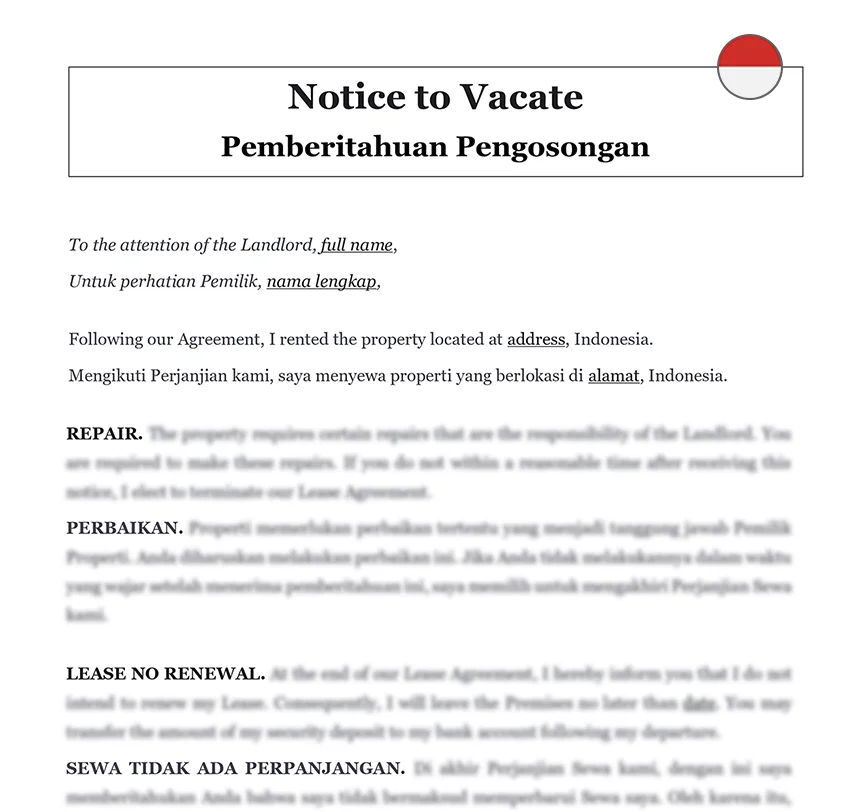Understanding How to Issue a Legal Move-Out Notice in Indonesia
Issuing a legal move-out notice is an essential part of managing rental properties in Indonesia. Whether you’re ending a lease due to its natural expiration, addressing issues like non-payment, or dealing with a breach of lease terms, a properly issued move-out notice ensures that both parties fulfill their legal obligations and facilitates a smooth transition. This notice not only formalizes the end of the tenancy but also helps avoid potential disputes by clearly communicating the requirements and timelines. Understanding the correct procedure for issuing a move-out notice will protect your rights as a property owner and ensure compliance with Indonesian rental laws. To streamline this process and ensure you have a legally sound document, consider using our notice to vacate template, which is designed to help you create an effective and compliant move-out notice.
Grounds for Issuing a Move-Out Notice
Issuing a move-out notice requires a clear understanding of the valid grounds for initiating this process. Here are the primary reasons you might need to issue a move-out notice in Indonesia:
1. Lease Term Expiration: When a lease term reaches its end, you may issue a move-out notice to formally notify the tenant that the lease will not be renewed. This ensures that both parties have clear expectations about the end date of the tenancy and allows for a smooth transition. Ensure the notice is given with sufficient lead time as specified in the lease agreement or local regulations.
2. Non-Payment of Rent: If a tenant consistently fails to pay rent, a move-out notice can be issued as a formal step towards eviction. Ensure you have documented evidence of missed payments and any previous attempts to resolve the issue before issuing the notice. This documentation will support your case if the matter escalates to legal proceedings.
3. Breach of Lease Terms: When a tenant violates significant terms of the lease agreement, such as unauthorized subletting, causing substantial property damage, or engaging in illegal activities, a move-out notice may be warranted. Detailed records of these breaches and any prior warnings given will be crucial in justifying the notice.
4. Property Use Changes: If you need to make significant changes to the property, such as major renovations or converting it to a different use, a move-out notice can be issued to facilitate these changes. Ensure that the notice provides adequate time for the tenant to vacate and outlines the reasons for the request.
ℹ️ For more detailed information on lease terms and conditions, refer to our comprehensive lease agreement.
Drafting the Move-Out Notice
Creating a legally sound move-out notice involves including specific details to ensure clarity and compliance with Indonesian rental laws. Here are the essential elements to include in your notice:
1. Tenant and Property Details: Clearly identify both parties by including the tenant’s full name and the property address. This ensures there is no confusion about which lease is being terminated and who the notice is directed towards.
2. Reason for Move-Out Notice: Specify the reason for issuing the notice. Whether it’s due to lease expiration, non-payment, or a breach of lease terms, clearly stating the reason helps in avoiding misunderstandings and provides the tenant with a clear explanation of why they are being asked to vacate.
3. Move-Out Date: Provide a specific date by which the tenant must vacate the property. This date should align with the notice period required by the lease agreement or local regulations. Make sure the timeline is reasonable and allows the tenant adequate time to make arrangements.
4. Contact Information: Include your contact details or those of the property manager for any further communication or clarification regarding the move-out process. This facilitates smooth communication and helps address any questions or concerns the tenant may have.
5. Legal Language: Use clear and formal language to ensure the notice meets legal standards. Avoid ambiguous terms and ensure that the notice complies with local legal requirements to avoid any disputes.
ℹ️ Using a professionally designed notice to vacate template can help you include all necessary elements and ensure that your move-out notice is comprehensive and legally compliant. Additionally, our eviction notice can be a valuable resource for managing more complex eviction situations.
Delivering the Move-Out Notice
Proper delivery of the move-out notice is crucial for ensuring its validity and effectiveness. Follow these steps to ensure the notice is delivered correctly and acknowledged by the tenant:
| ➤ Method of Delivery: Choose a legally recognized method for delivering the move-out notice. Common methods include hand delivery, certified mail, or posting the notice on the property. Each method has its own requirements for proof of delivery. |
| ➤ Proof of Delivery: Obtain and keep proof of delivery to confirm that the tenant received the notice. This could be a signed receipt if hand-delivered, a delivery confirmation if mailed, or a witness statement if posted on the property. |
| ➤ Documenting Receipt: If possible, request a written acknowledgment from the tenant confirming receipt of the notice. This can help avoid disputes about whether the notice was received and when. |
| ➤ Follow-Up Communication: After delivering the notice, follow up with the tenant to confirm their understanding and compliance. This can help address any questions and ensure a smooth transition. |
Handling Post-Move-Out Procedures
Once the move-out notice has been issued and the tenant has vacated the property, it’s crucial to manage the post-move-out procedures effectively. Begin with a thorough property inspection to assess any damages and ensure the property is in good condition for future tenants. Address necessary repairs promptly, such as fixing appliances or repainting walls, to maintain the property’s value. Also, handle the security deposit according to the lease agreement and local regulations, providing an itemized list of any deductions for damages or unpaid rent. Updating your property management records to reflect the lease termination and the property’s condition is essential for accurate documentation. For a comprehensive approach to managing tenant transitions and property inspections, you might find our rental inspection checklist and eviction notice templates useful. If you need further assistance, feel free to contact us.
Ask your question and receive legal advice from a qualified lawyer
310 client reviews (4.8/5) ⭐⭐⭐⭐⭐











